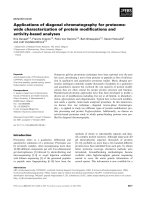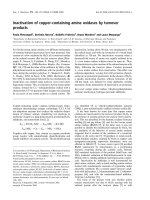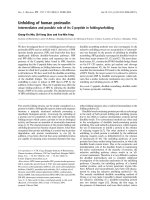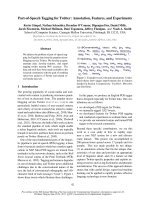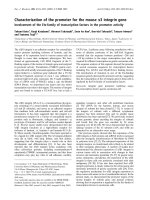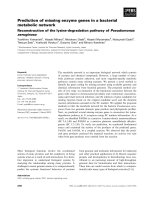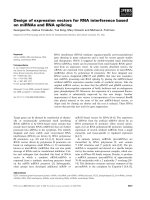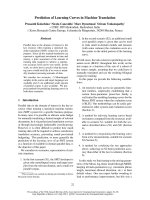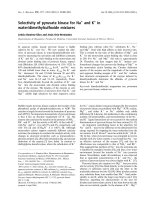Báo cáo khoa học: "Prediction of Thematic Rank for Structured Semantic Role Labeling" doc
Bạn đang xem bản rút gọn của tài liệu. Xem và tải ngay bản đầy đủ của tài liệu tại đây (135.32 KB, 4 trang )
Proceedings of the ACL-IJCNLP 2009 Conference Short Papers, pages 253–256,
Suntec, Singapore, 4 August 2009.
c
2009 ACL and AFNLP
Prediction of Thematic Rank for Structured Semantic Role Labeling
Weiwei Sun and Zhifang Sui and Meng Wang
Institute of Computational Linguistics
Peking University
Key Laboratory of Computational Linguistics
Ministry of Education, China
;{wm,szf}@pku.edu.cn
Abstract
In Semantic Role Labeling (SRL), it is rea-
sonable to globally assign semantic roles
due to strong dependencies among argu-
ments. Some relations between arguments
significantly characterize the structural in-
formation of argument structure. In this
paper, we concentrate on thematic hierar-
chy that is a rank relation restricting syn-
tactic realization of arguments. A log-
linear model is proposed to accurately
identify thematic rank between two argu-
ments. To import structural information,
we employ re-ranking technique to incor-
porate thematic rank relations into local
semantic role classification results. Exper-
imental results show that automatic pre-
diction of thematic hierarchy can help se-
mantic role classification.
1 Introduction
In Semantic Role Labeling (SRL), it is evident that
the arguments in one sentence are highly corre-
lated. For example, a predicate will have no more
than one Agent in most cases. It is reasonable to
label one argument while taking into account other
arguments. More structural information of all ar-
guments should be encoded in SRL approaches.
This paper explores structural information of
predicate-argument structure from the perspec-
tive of rank relations between arguments. The-
matic hierarchy theory argues that there exists a
language independent rank of possible semantic
roles, which establishes priority among arguments
with respect to their syntactic realization (Levin
and Hovav, 2005). This construct has been widely
implicated in linguistic phenomena, such as in the
subject selection rule of Fillmore’s Case Grammar
(1968): ”If there is an A [=Agent], it becomes the
subject; otherwise, if there is an I [=Instrument],
it becomes the subject; otherwise, the subject is
the O [=Object, i.e., Patient/Theme]”. This rule
implicitly establishes precedence relations among
semantic roles mentioned and can be simplified to:
Agent Instrument Patient/Theme
Emerging from a range of more basic semantic
properties of the ranked semantic roles, thematic
hierarchies can help to construct mapping from se-
mantics to syntax. It is therefore an appealing op-
tion for argument structure analysis. For example,
if the the rank of argument a
i
is shown higher than
a
j
, then the assignment [a
i
=Patient, a
j
=Agent] is
illegal, since the role Agent is the highest role.
We test the hypothesis that thematic rank be-
tween arguments can be accurately detected by
using syntax clues. In this paper, the concept
”thematic rank” between two arguments a
i
and a
j
means the relationship that a
i
is prior to a
j
or a
j
is
prior to a
i
. Assigning different labels to different
relations between a
i
and a
j
, we formulate predic-
tion of thematic rank between two arguments as a
multi-class classification task. A log-linear model
is put forward for classification. Experiments on
CoNLL-2005 data show that this approach can
get an good performance, achieving 96.42% ac-
curacy on gold parsing data and 95.14% accuracy
on Charniak automatic parsing data.
Most existing SRL systems divide this task into
two subtasks: Argument Identification (AI) and
Semantic Role Classification (SRC). To add struc-
tural information to a local SRL approach, we in-
corporate thematic hierarchy relations into local
classification results using re-ranking technique
in the SRC stage. Two re-ranking approaches,
1) hard constraint re-ranking and 2) soft con-
straint re-ranking, are proposed to filter out un-
like global semantic role assignment. Experiments
on CoNLL-2005 data indicate that our method
can yield significant improvement over a state-of-
the-art SRC baseline, achieving 0.93% and 1.32%
253
absolute accuracy improvements on hand-crafted
and automatic parsing data.
2 Prediction of Thematic Rank
2.1 Ranking Arguments in PropBank
There are two main problems in modeling the-
matic hierarchy for SRL on PropBank. On the one
hand, there is no consistent meaning of the core
roles (i.e. Arg0-5/ArgA). On the other hand, there
is no consensus over hierarchies of the roles in the
thematic hierarchy. For example, the Patient occu-
pies the second highest hierarchy in some linguis-
tic theories but the lowest in some other theories
(Levin and Hovav, 2005).
In this paper, the proto-role theory (Dowty,
1991) is taken into account to rank PropBank argu-
ments, partially resolving the two problems above.
There are three key points in our solution. First,
the rank of Arg0 is the highest. The Agent is al-
most without exception the highest role in pro-
posed hierarchies. Though PropBank defines se-
mantic roles on a verb by verb basis, for a particu-
lar verb, Arg0 is generally the argument exhibit-
ing features of a prototypical Agent while Arg1
is a prototypical Patient or Theme (Palmer et al.,
2005). As being the proto-Agent, the rank of Arg0
is higher than other numbered arguments. Second,
the rank of the Arg1 is second highest or lowest.
Both hierarchy of Arg1 are tested and discussed in
section 4. Third, we do not rank other arguments.
Two sets of roles closely correspond to num-
bered arguments: 1) referenced arguments and 2)
continuation arguments. To adapt the relation to
help these two kinds of arguments, the equivalence
relation is divided into several sub-categories. In
summary, relations of two arguments a
i
and a
j
in
this paper include: 1) a
i
a
j
: a
i
is higher than
a
j
, 2) a
i
≺ a
j
: a
i
is lower than a
j
, 3) a
i
ARa
j
: a
j
is the referenced argument of a
i
, 4) a
i
RAa
j
: a
i
is
the referenced argument of a
j
, 5) a
i
ACa
j
: a
j
is
the continuation argument of a
i
, 6) a
i
CAa
j
: a
i
is
the continuation argument of a
j
, 7) a
i
= a
j
: a
i
and a
j
are labeled as the same role label, and 8)
a
i
∼ a
j
: a
i
and a
j
are labeled as the Arg2-5, but
not in the same type.
2.2 Prediction Method
Assigning different labels to possible rank be-
tween two arguments a
i
and a
j
, such as labeling
a
i
a
j
as ””, identification of thematic rank
can be formulated as a classification problem. De-
lemma, POS Tag, voice, and SCF of predicate
categories, position of two arguments; rewrite
rules expanding subroots of two arguments
content and POS tags of the boundary words
and head words
category path from the predicate to candidate
arguments
single character category path from the
predicate to candidate arguments
conjunction of categories, position, head
words, POS of head words
category and single character category path
from the first argument to the second argument
Table 1: Features for thematic rank identification.
note the set of relations R. Formally, given a score
function S
T H
: A × A × R → R, the relation r is
recognized in argmax flavor:
ˆr = r
∗
(a
i
, a
j
) = arg max
r∈R
S
T H
(a
i
, a
j
, r)
A probability function is chosen as the score func-
tion and the log-linear model is used to estimate
the probability:
S
T H
(a
i
, a
j
, r) =
exp{ψ(a
i
, a
j
, r) · w}
r∈R
exp{ψ(a
i
, a
j
, r) · w}
where ψ is the feature map and w is the param-
eter vector to learn. Note that the model pre-
dicts the rank of a
i
and a
j
through calculating
S
T H
(a
i
, a
j
, r) rather than S
T H
(a
j
, a
i
, r), where
a
i
precedes a
j
. In other words, the position infor-
mation is implicitly encoded in the model rather
than explicitly as a feature.
The system extracts a number of features to rep-
resent various aspects of the syntactic structure of
a pair of arguments. All features are listed in Table
1. The Path features are designed as a sequential
collection of phrase tags by (Gildea and Jurafsky,
2002). We also use Single Character Category
Path, in which each phrase tag is clustered to a cat-
egory defined by its first character (Pradhan et al.,
2005). To characterize the relation between two
constituents, we combine features of the two indi-
vidual arguments as new features (i.e. conjunction
features). For example, if the category of the first
argument is NP and the category of the second is S,
then the conjunction of category feature is NP-S.
3 Re-ranking Models for SRC
Toutanova et al. (2008) empirically showed that
global information is important for SRL and that
254
structured solutions outperform local semantic
role classifiers. Punyakanok et al. (2008) raised an
inference procedure with integer linear program-
ming model, which also showed promising results.
Identifying relations among arguments can pro-
vide structural information for SRL. Take the sen-
tence ”[
Arg0
She] [
V
addressed] [
Arg1
her hus-
band] [
ArgM −MN R
with her favorite nickname].”
for example, if the thematic rank of she and her
husband is predicted as that she is higher than her
husband, then her husband should not be assigned
the highest role.
To incorporate the relation information to lo-
cal classification results, we employ re-ranking ap-
proach. Assuming that the local semantic classi-
fier can produce a list of labeling results, our sys-
tem then attempts to pick one from this list accord-
ing to the predicted ranks. Two different polices
are implemented: 1) hard constraint re-ranking,
and 2) soft constraint re-ranking.
Hard Constraint Re-ranking The one picked
up must be strictly in accordance with the ranks.
If the rank prediction result shows the rank of ar-
gument a
i
is higher than a
j
, then role assignments
such as [a
i
=Patient and a
j
=Agent] will be elim-
inated. Formally, the score function of a global
semantic role assignment is:
S(a, s) =
i
S
l
(a
i
, s
i
)
i,j,i<j
I(r
∗
(a
i
, a
j
), r(s
i
, s
j
))
where the function S
l
locally scores an argument;
r
∗
: A × A → R is to predict hierarchy of two
arguments; r : S × S → R is to point out the the-
matic hierarchy of two semantic roles. For exam-
ple, r(Agent, P atient) = ” ”. I : R × R →
{0, 1} is identity function.
In some cases, there is no role assignment sat-
isfies all predicted relations because of prediction
mistakes. For example, if the hierarchy detec-
tion result of a = (a
1
, a
2
, a
3
) is (r
∗
(a
1
, a
2
) =
, r
∗
(a
2
, a
3
) =, r
∗
(a
1
, a
3
) =≺), there will be no
legal role assignment. In these cases, our system
returns local SRL results.
Soft Constraint Re-ranking In this approach,
the predicted confidence score of relations is
added as factor items to the score function of the
semantic role assignment. Formally, the score
function in soft constraint re-ranking is:
S(a, s) =
i
S
l
(a
i
, s
i
)
i,j,i<j
S
T H
(a
i
, a
j
, r(s
i
, s
j
))
4 Experiments
4.1 Experimental Settings
We evaluated our system using the CoNLL-2005
shared task data. Hierarchy labels for experimen-
tal corpora are automatically set according to the
definition of relation labels described in section
2.1. Charniak parser (Charniak, 2000) is used for
POS tagging and full parsing. UIUC Semantic
Role Labeler
1
is a state-of-the-art SRL system. Its
argument classification module is used as a strong
local semantic role classifier. This module is re-
trained in our SRC experiments, using parameters
described in (Koomen et al., 2005). Experiments
of SRC in this paper are all based on good ar-
gument boundaries which can filter out the noise
raised by argument identification stage.
4.2 Which Hierarchy Is Better?
Detection SRL (S) SRL (G)
Baseline – 94.77% –
A 94.65% 95.44% 96.89%
A & P↑ 95.62% 95.07% 96.39%
A & P↓ 94.09% 95.13% 97.22%
Table 2: Accuracy on different hierarchies
Table 2 summarizes the performance of the-
matic rank prediction and SRC on different the-
matic hierarchies. All experiments are tested on
development corpus. The first row shows the per-
formance of the local sematic role classifier. The
second to the forth rows show the performance
based on three ranking approach. A means that
the rank of Agent is the highest; P↑ means that the
rank of Patient is the second highest; P↓ means
that the rank of the Patient is the lowest. Col-
umn SRL(S) shows SRC performance based on
soft constraint re-ranking approach, and column
SRL(G) shows SRC performance based on gold
hierarchies. The data shows that the third the-
matic hierarchy fits SRL best, but is harder to
learn. Compared with P↑, P↓ is more suitable for
SRL. In the following SRC experiments, we use
the first hierarchy because it is most helpful when
predicted relations are used.
4.3 Results And Improvement Analysis
Table 3 summarizes the precision, recall, and F-
measure of this task. The second column is fre-
quency of relations in the test data, which can be
1
/>255
seen as a simple baseline. Moreover, another natu-
ral baseline system can predict hierarchies accord-
ing to the roles classified by local classifier. For
example, if the a
i
is labeled as Arg0 and a
j
is la-
beled as Arg2, then the relation is predicted as .
The third column BL shows the F-measure of this
baseline. It is clear that our approach significantly
outperforms the two baselines.
Rel Freq. BL P(%) R(%) F
57.40 94.79 97.13 98.33 97.73
≺ 9.70 51.23 98.52 97.24 97.88
∼ 23.05 13.41 94.49 93.59 94.04
= 0.33 19.57 93.75 71.43 81.08
AR 5.55 95.43 99.15 99.72 99.44
AC 3.85 78.40 87.77 82.04 84.81
CA 0.16 30.77 83.33 50.00 62.50
All – 75.75 96.42
Table 3: Thematic rank prediction performance
Table 4 summarizes overall accuracy of SRC.
Baseline performance is the overall accuracy of
the local classifier. We can see that our re-ranking
methods can yield significant improvemnts over
the baseline.
Gold Charniak
Baseline 95.14% 94.12%
Hard 95.71% 94.74%
Soft 96.07% 95.44%
Table 4: Overall SRC accuracy.
Hierarchy prediction and re-ranking can be
viewed as modification for local classification re-
sults with structural information. Take the sen-
tence ”[Some ’circuit breakers’ installed after the
October 1987] crash failed [their first test].” for
example, where phrases ”Some 1987” and
”their test” are two arguments. The table be-
low shows the local classification result (column
Score(L)) and the rank prediction result (column
Score(H)). The baseline system falsely assigns
roles as Arg0+Arg1, the rank relation of which is
. Taking into account rank prediction result that
relation ∼ gets a extremely high probability, our
system returns Arg1+Arg2 as SRL result.
Assignment Score(L) Score(H)
Arg0+Arg1 78.97% × 82.30% :0.02%
Arg1+Arg2 14.25% × 11.93% ∼:99.98%
5 Conclusion and Future Work
Inspired by thematic hierarchy theory, this paper
concentrates on thematic hierarchy relation which
characterize the structural information for SRL.
The prediction of thematic rank is formulated as
a classification problem and a log-linear model
is proposed to solve this problem. To improve
SRC, we employ re-ranking technique to incorpo-
rate thematic rank information into the local se-
mantic role classifier. Experimental results show
that our methods can construct high-performance
thematic rank detector and that identification of ar-
guments’ relations can significantly improve SRC.
Acknowledgments
This work is supported by NSFC Project
60873156, 863 High Technology Project of
China 2006AA01Z144 and the project of Toshiba
(China) Co., Ltd. R&D Center.
References
Eugene Charniak. 2000. A Maximum-Entropy-
Inspired Parser. In Proceedings of NAACL-00.
David R. Dowty. 1991. Thematic proto-roles and ar-
gument selection. Language, 67:547–619.
Charles Fillmore. 1968. The case for case. In Em-
mon Bach and Richard Harms, editors, Universals
in Linguistic Theory, pages 1–90. Holt, Rinehart and
Winston, New York, New York.
Daniel Gildea and Daniel Jurafsky. 2002. Automatic
labeling of semantic roles. Computational Linguis-
tics, 28:245–288.
Peter Koomen, Vasin Punyakanok, Dan Roth, and
Wen-tau Yih. 2005. Generalized inference with
multiple semantic role labeling systems. In Pro-
ceedings of the CoNLL-2005, pages 181–184, June.
Beth Levin and Malka Rappaport Hovav. 2005. Argu-
ment Realization. Research Surveys in Linguistics.
Cambridge University Press, New York.
Martha Palmer, Daniel Gildea, and Paul Kingsbury.
2005. The proposition bank: An annotated corpus
of semantic roles. Computational Linguistics, 31.
Sameer Pradhan, Kadri Hacioglu, Valerie Krugler,
Wayne Ward, James H. Martin, and Daniel Jurafsky.
2005. Support vector learning for semantic argu-
ment classification. In Machine Learning.
Vasin Punyakanok, Dan Roth, and Wen-tau Yih. 2008.
The importance of syntactic parsing and inference in
semantic role labeling. Comput. Linguist.
Kristina Toutanova, Aria Haghighi, and Christopher D.
Manning. 2008. A global joint model for semantic
role labeling. Comput. Linguist.
256

